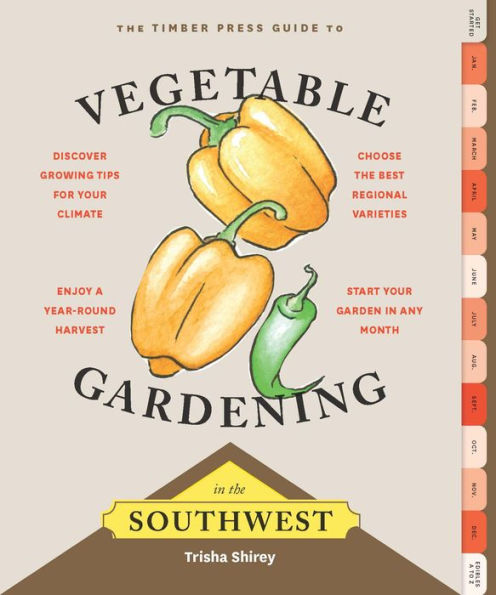Read an Excerpt
Preface Some of my earliest and fondest memories are from time spent helping out in our family garden when I was young. My mother would can, pickle, and freeze our harvests and we would eat from the garden throughout the year. Our pantry shelves were lined with colorful jars of pickled beets and peaches, green beans, and tomatoes. My mother cooked three meals a day for our family of eight, and every meal was made from scratch—no frozen dinners or take-out—and most of the ingredients came from the garden. My siblings and I were very involved with the preparation and cleanup with every meal. As I grew up, the idea of growing and cooking my own food was never daunting—my parents did it, their parents did it before them, and so on. When asked why I bother with keeping a garden, I usually think of Weezer from the wonderful Steel Magnolias (beautifully played by Shirley MacLaine). She grew tomatoes and forced them on her friends because she didn’t much like them herself. When they asked her why, she replied, “Because I’m an old southern woman and we’re supposed to wear funny looking hats and ugly clothes and grow vegetables in the dirt. I don’t know why! I don’t make the rules.” Funny hats? Check. Ugly clothes? Check. Like Weezer, it just seems like I am supposed to do this. Fortunately, I like tomatoes and certainly don’t have any friends that would turn down my surplus bounty. You don’t always have to find your dinner at the grocery store; you can pick from whatever is ready for harvesting in your garden. What’s more, you won’t have to ask any questions about whether it’s organic or nutritious and flavorful—you’ll have nurtured the plant from it’s beginnings as a tiny seed or transplant. You control the conditions. My garden has even turned me into a more adventurous cook—when you’re eating kale three or more days of the week, you’ll want to have more than a few recipes to rely on. Unfortunately, many Americans have missed out on the experience of growing up with a food garden. Something that seems so natural to me is still mysterious and complex to so many of my friends. They’re often intrigued and excited by the idea of growing their own food, but don’t know where to begin. Still, from First Lady Michelle Obama’s organic garden at the White House to the exploding trend of food-filled back yards and patios across the nation, more people than ever are now getting into gardening. Seed companies and garden centers are reporting that sales of herb and vegetable seeds and plants are increasing every year. What could be fresher than produce picked right before it goes on your table? Nutrients and flavor are not lost during transportation and your food hasn’t been shipped across the country, contributing to pollution and global warming. You’ll learn to appreciate the variety of food that’s available each season. I might not have fresh tomatoes in late winter or lettuce in midsummer, but there are so many wonderful seasonal alternatives. You can say goodbye to those transported out-of-season offerings that you find at the grocery store. You can also stop worrying about food contamination, as you’ll know exactly what you used on your own garden. Growing crops organically in healthy soil can result in produce with higher levels of vitamin C, iron, phosphorus, antioxidants, and other nutrients. A study by the University of Florida and Washington State found that organic foods contain, on average, about 25 percent higher levels of 11 nutrients than their traditional counterparts. And your investment will go so much further—you can cut your food bills and eat healthier. The National Gardening Association found that a family that invested $70 in a garden could harvest about $600 worth of vegetables. You’ll find that there are physical rewards of gardening also. Vigorous garden work can help to increase bone density and reduce blood pressure and cholesterol. Exercising the mind and body with the planning and care of a garden can reduce stress and the risk of dementia. Studies have shown that gardeners have reduced levels of blood sugar and a lower risk of type 2 diabetes. Many gardeners find weeding, pruning, watering, and other gardening chores meditative and a great way to unwind from a hectic day. There is pleasure to be taken in watching things grow; you’ll develop a connection to natural cycles and feel more self-reliant and empowered. Your children will learn that vegetables don’t always have to come from a bag in the freezer and they might be more likely to eat them when they have helped to grow and harvest them. You just might instill a love of gardening that will last a lifetime! As long as you have at least six hours of sunlight, good air circulation, and access to water, you can grow a great variety of herbs and vegetables in a garden bed or containers. Even in shady locations, parsley, chives, mint, and lettuce can thrive. And a yard isn’t always necessary; determined renters and apartment dwellers can always find space to grow their favorite edibles, whether in containers or in community gardens. Sure there will be a few failures along the way, but that’s how we learn. I still plant tomatoes that fail to produce a single fruit as a result of unseasonably warm spring temperatures or green beans that succumb to powdery mildew or cucumbers that won’t bloom. It happens to all of us—gardening is a gamble. But at least we can compost our failures to build healthy soil for the next season!



